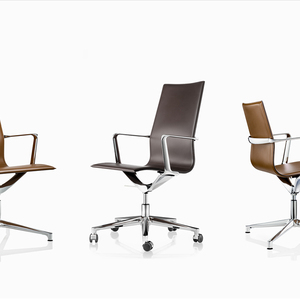Italian office chairs in accordance with the regulations

In order to protect the health of individuals who work in offices by sitting for many hours a day, prerequisites have been established for Italian office chairs to comply with the law and be manufactured in accordance with certain ergonomic and functional principles contained in the following standards:
- UNI EN 1335.1, which concerns the determination of dimensions;
- UNI EN 1335-2, which concerns safety requirements;
- UNI EN 1335-3, which covers test methods for safety.
Based on certain performance features, Italian office chairs are categorized into three different classes, which are:
- class A, this is the most restrictive class, which especially respects anthropometric dimensions from 5% to 95% of the entire population;
- class B, which respects the minimum requirements established by Legislative Decree 626;
- class C, which allows greater freedom of choice, still meeting the minimum requirements.
FEATURES OF ITALIAN OFFICE CHAIRS
The categorization into three types of Italian office chairs is mainly focused on the dimensions. Dimensions must be respected meticulously, as this factor proves to be crucial to the well-being of the person forced to sit for many hours. The posture of the body can easily be altered if the support does not fit the anatomical characteristics of the back; in fact, by sitting for long periods of time, the thoracolumbar musculature (which supports the osteo-articular apparatus) tends to relax, becoming more vulnerable to assuming incorrect postures. The size of a legally compliant Italian office chair must provide adequate space to accommodate the individual's body without constriction, offering freedom of movement. Such Italian chairs are equipped with a backrest, which performs the task of supporting the back; all chairs without a backrest in fact allow the back to bend forward, contributing to abnormal positions and likely to cause discomfort. Many pathologies concerning the back, such as low back pain, arthrosis or scoliosis, can result from the repetition of incorrect postures, which, over time, tend to become chronic. On the other hand, the presence of armrests is optional since the position of the upper limbs is often conditioned by the type of activity performed by the subject, who does not always need to rest his or her arms on supports. Another necessary requirement is the possibility of horizontal rotation of the seat, which must be adjustable in height. The height of the seat in relation to the work surface is another fundamental prerequisite for the anatomical well-being of the individual; in fact, during the hours of activity, it is essential that the surface where the work is carried out reaches the chest, to allow b>proper support of the arms and a correct position of the back. The ability to rotate the seat minimizes rotational movements of the trunk, decreasing the risk of functional impairment of the muscular apparatus; in this way, the torso remains upright and leaning against the backrest even when turning in horizontal direction.
REQUIREMENTS FOR OFFICE CHAIRS
The requirements for a legally compliant office chair are based on certain parameters relating to the person:
- use of the chair for at least eight hours a day;
- weight of the person not exceeding 110 kilograms;
- height not exceeding 190 centimeters.
In order to approve a product, it must have passed certain safety tests relating to load, mass and dimensions.
Requirements that can be attached to the chair are also indispensable:
- stability;
- durability;
- strength;
- type of constituent materials, which must possess certain attributes (hypo allergenicity, hygienic performance, etc.).
These tests are carried out on all chair components and consist of applying forces that simulate those of normal use, in order to assess individual functional properties. Once the various tests have been passed, a test report is generally filled to certify the suitability of the product according to the reference standard.
Aesthetic factors are not analyzed and are the sole responsibility of the manufacturers.
One of the most important requirements for an office chair is ergonomics: this feature takes into account the anatomical peculiarities of a person in relation to the function they perform. In other words, it represents the method of interaction between person and technology.
An ergonomic Italian office chair ensure a correct postural posture following these requirements:
- its backrest is not straight but has an 'S' shape to adapt itself to the shape of the spinal column;
- there is a reinforcement in the lumbar region to support this very vulnerable anatomical part;
- the constituent materials must guarantee comfort, such as softness, free passage of air, etc.;
- they are adjustable to suit individual needs; both the height from the ground and the height of the armrests can be chosen, and it is also important to adjust the position of the backrest and its height;
- in some cases, they are equipped with a reclining backrest, which allows a semi-reclining position that is particularly useful for relaxing the neck muscles;
- when present, it is possible to raise the footrest structure to elevate the legs, with obvious benefits for their venous circulation and muscle tension.
Italian Office Furniture
-
Executive Desk
-
Design Desk
-
Modern Desk
-
Luxury Desk
-
Workstation Desk
Italian Office Chairs
-
Executive Office Chairs
-
Designer Office Chairs
-
Classic Office Chairs
-
Waiting Room Chairs
-
Meeting Room Chairs
-
Auditorium Seating
Meeting
-
Meeting Table
-
Receptionist Desks
-
Agile Workspaces
-
University Bench
-
Designer Lamps
Partitions
-
Partition Walls
-
Office Pods and Booths
-
Bookshelf Wall
-
Interior Doors
-
Cabinets & Wardrobes
Must have
-
...can't live without



